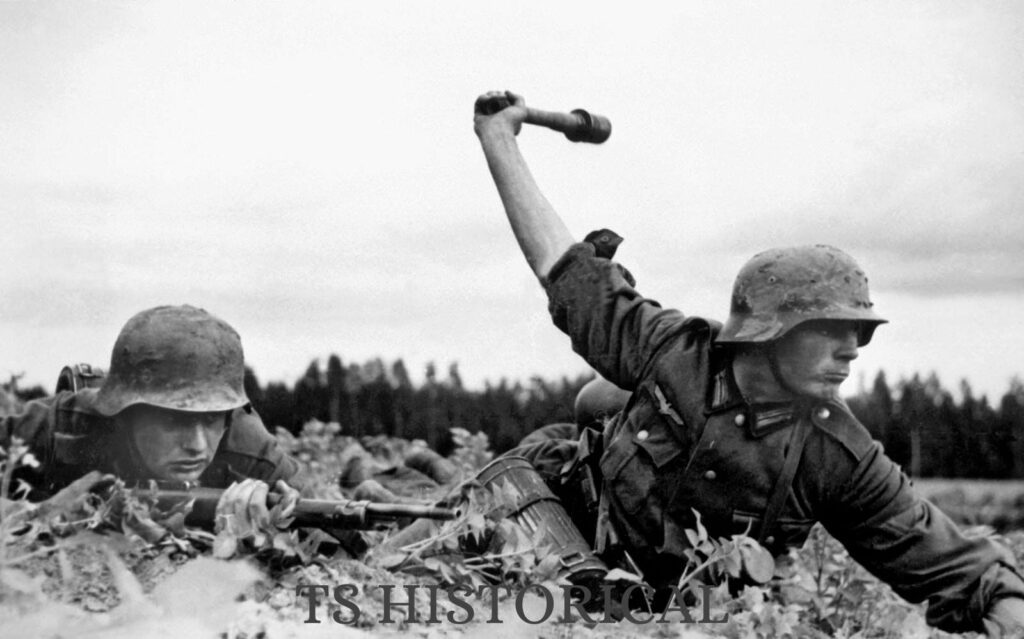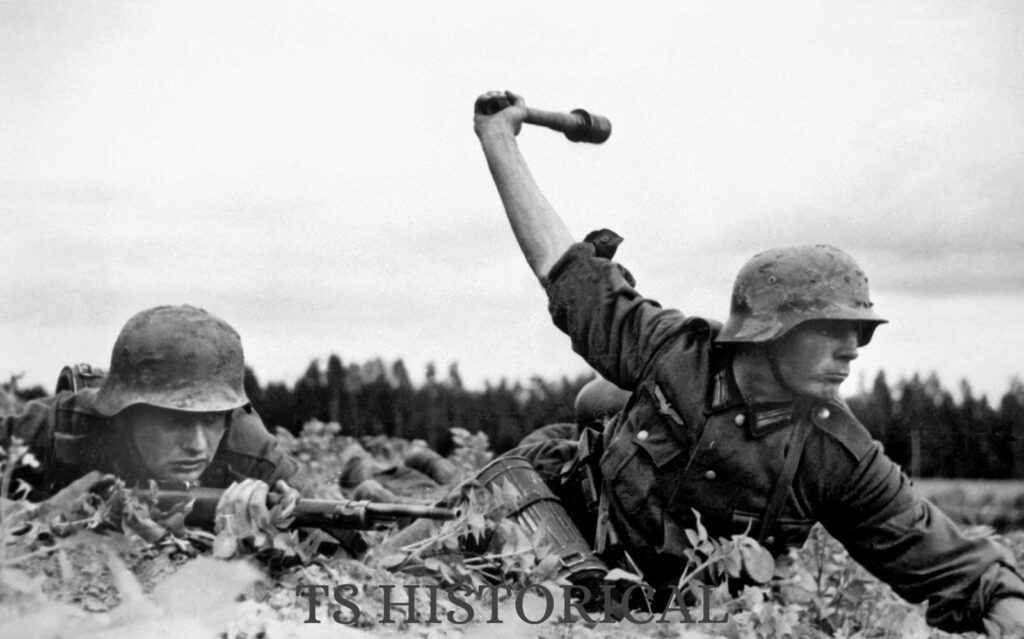
| Date: | 22 June – 5 December 1941 (5 months, 1 week, and 6 days) |
| Location: | Central Europe, (Northeast Europe), Eastern Europe |
| Context: | World War II |
| Participants: | Germany, Red Army, Soviet Union |
Table of Content
Nazi Germany Invades Soviet Union
Nazi Germany launched Operation Barbarossa – the invasion of the Soviet Union – nearly two years after the start of World War II. It was one of the most sizable and deadliest conflicts of all time and one that the USSR would not recover from economically until the 1960s. The estimate is that over twenty million Russians lost their lives in this invasion. Overall, the Soviet Union suffered more losses than any other country involved in World War II.
Before war broke out, Josef Stalin, the communist leader of the Soviet Union, was working with the German military. World War I had ended less than amicably for the Germans, and many resented the outcome. Stalin allowed German armed forced to secretly train in the Soviet Union, as the Treaty of Versailles had placed limitations on Germany’s military.
In return, Germany supplied Stalin with machine parts and other goods. Despite being staunchly anti-communist, when Adolf Hitler assumed power, he continued taking advantage of this trade-off. Stalin knew that war with Germany was inevitable, as Hitler had asserted as much in his manifesto “Mein Kampf.” But he hoped to direct Germany’s attention to France and Britain, allowing him more time to strengthen his army.
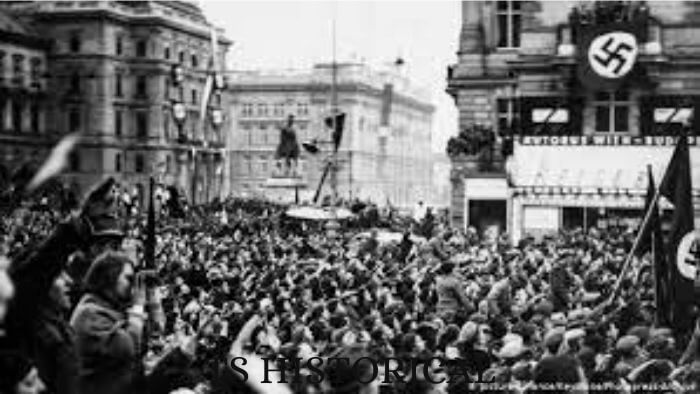
In 1936, Adolf Hitler started to re-establish Germany’s power. He annexed Austria and took over Czechoslovakia, manipulating the French and British into standing down in the name of peace.
The Nazis then formed alliances with Hungary, Romania, Italy, and Japan. By the time Stalin realized what was happening, he found himself surrounded by German allies. With France and Britain unwilling to declare war, he had to negotiate with Hitler. Behind the announcement of trade agreements and a pledge not to go to war with each other, Hitler secretly agreed not to interfere if Stalin attacked Finland and also gave Stalin free reign to take over the Baltic States and parts of Romania.
Download this Article in PDF Format
Get a well-documented version of this article for offline reading or archiving.
Download Now (2008 KB)They then divided Poland between them, which they felt was justified as Poland had been under Prussian and Soviet control before gaining its independence after World War I. While Stalin seemed to get the better end of this deal, what Hitler wanted was the assurance that the Soviets would allow Germany to wage war on France.
In September of 1939, Hitler and Stalin attacked Poland from opposite sides, their armies meeting on the agreed stopping lines to congratulate each other. World War II had begun. Shortly after this campaign, Stalin’s Red Army attacked Finland. Although Russia was victorious and the Finns had to cede parts of their territory, the Red Army did not perform well. The Finns outfought them, and it was only the Red Army’s weight in numbers that saved them from defeat. The reason behind the poor performance by the Red Army was Stalin’s paranoia.
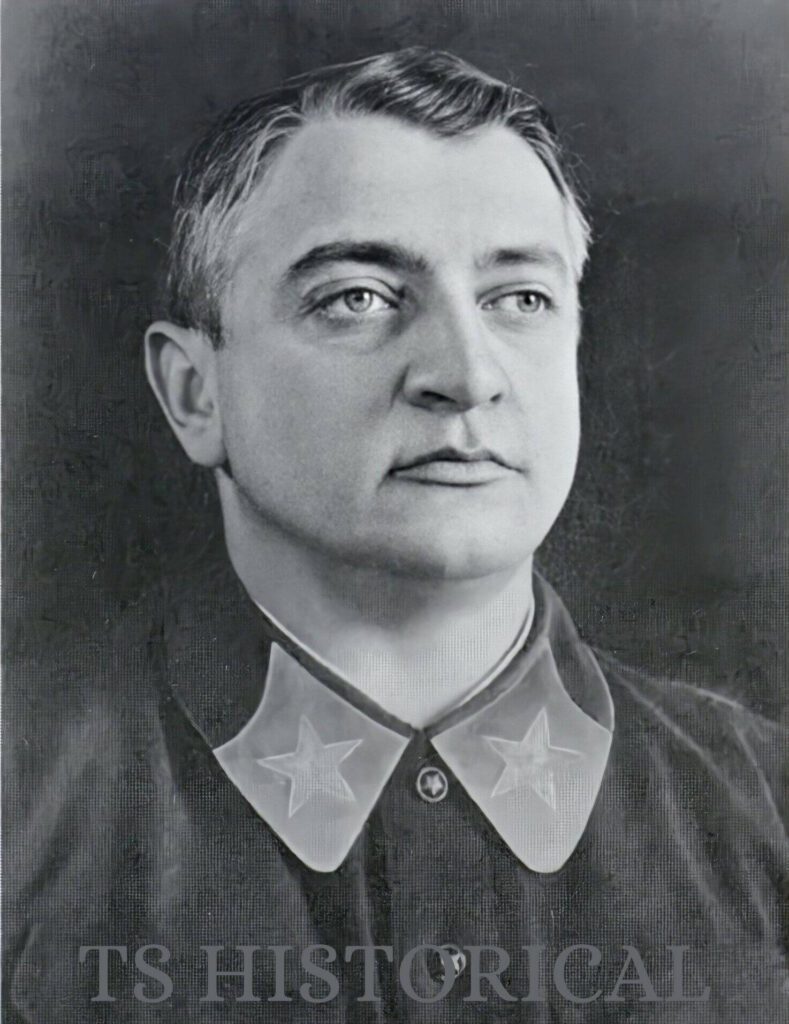
In 1937, Mikhail Tukhachevsky – a popular Soviet military chief who wanted to modernize the military – was in charge of the Red Army. Some believe that Stalin saw Tukhachevsky as a rival, which caused him to purge the Red Army of anyone suspected of having anti-communist or anti-Stalin sentiment.
Thirty-seven thousand officers were either killed, sent to Siberian labor camps, or jailed. Marshals, generals, and admirals were all executed, along with roughly ninety percent of corps commanders and eighty-two percent of division generals. Along with these upper echelons, Stalin also removed some colonels, majors, and captains.
The communist thinking was that trained commanders weren’t necessary, as “revolutionary zeal” would be enough for them to prevail. By the time the Soviets went to war with Finland, most of the army’s officers were afraid of going against orders, so they dared not think for themselves. Revolutionary zeal meant the only strategy at their disposal was sending waves of men out to die.
Despite being outnumbered, the Finns held off the Soviets for two months. After heavy casualties, Stalin reorganized, adopting different tactics, renewed the offensive, and in February of 1940, the Finns negotiated the Moscow Peace Treaty.
The military incompetence displayed by the Soviets during the Winter War with Finland spurred Hitler to start Operation Barbarossa. He hoped for a quick victory to avoid the harsh Russian winter. However, he had greatly underestimated the industry and size of the Soviet Army.
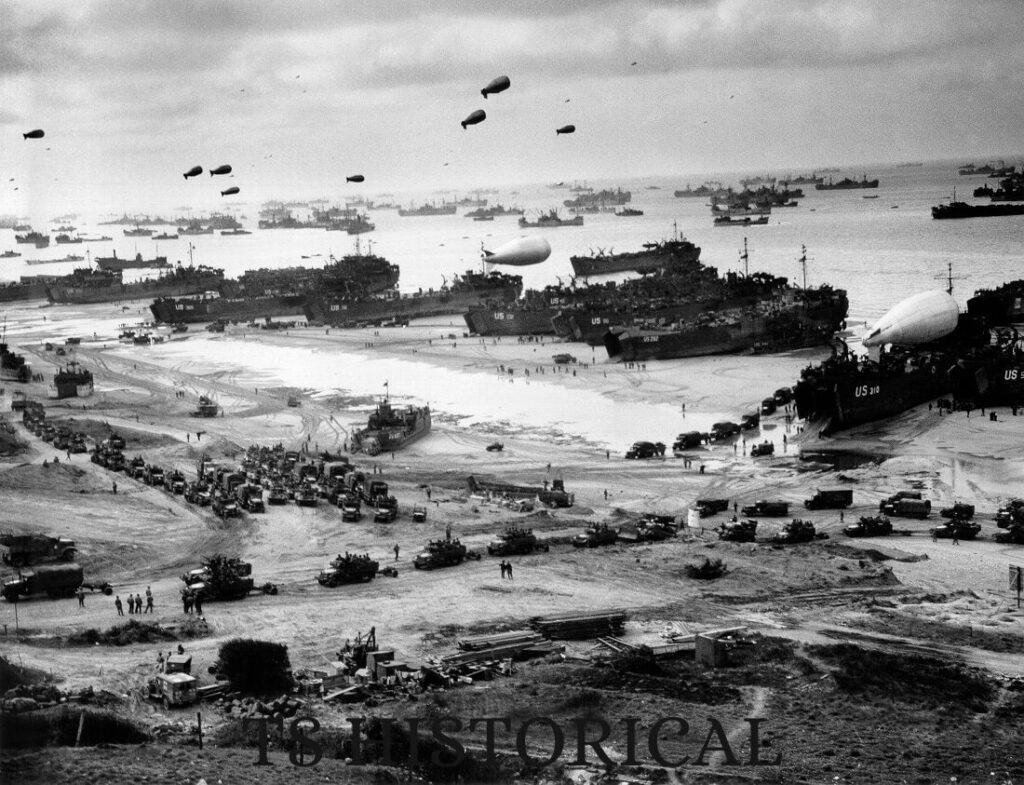
Germans amassed the largest invasion force in history
The Germans amassed the largest invasion force in history (although the Soviets would beat this record in the coming years) supplemented by Finnish, Italian, Romanian, and Hungarian formations. Both sides had a vast array of weapons, including tanks and heavy artillery. Although the German tanks were inferior to many of the Allied tanks, the German’s training and tactics would gain them victories during the first two years of World War II.
The Germans overwhelmed their enemies by finding weak points, then send in tanks – supported by air attacks – through the enemy’s front line. These attackers continued to the rear, where they cut off supplies and communications. The German infantry would then follow and take out any enemy units still on the front line.
This style of operation was known as a blitzkrieg attack. Many people, including Winston Churchill, warned Stalin of Hitler’s intentions to invade, but he chose to ignore them. German reconnaissance planes were left unchallenged, with Stalin not wanting to provoke an incident unnecessarily.
He believed the Red Army was unprepared for conflict with Germany and wished to prevent it for as long as possible. Luckily for the Soviets, Stalin would listen to some intelligence from one of his agents in Tokyo later that year. The information was that Japan intended to go to war with the US rather than the USSR, which prompted Stalin to move vast numbers of militia from the east to Moscow. Shortly after 3 am on June 22, 1941, three million Germans and their allies stormed across the borders of Poland, the Baltic States, Ukraine, and Finland.
The Red army was entirely unprepared for this onslaught, and a large number of Soviet troops found themselves surrounded before they realized what was happening. During the first battle, nearly half a million Soviet soldiers lost their lives. Stalin was devastated. Ashamed that he had not believed Germany would attack, he didn’t speak publicly until over a week after the initial invasion. Stalin then abandoned his communist fervor, naming the defense effort the Great Patriotic War. He brought back forbidden symbols and old traditions to make the war more about national survival than communist ideals.
War of Annihilation
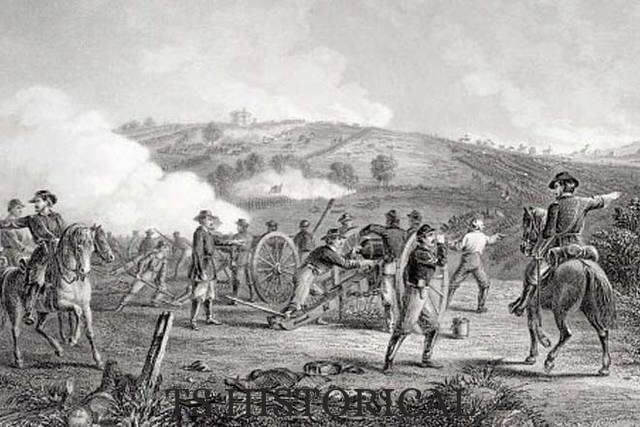
Hitler referred to this operation as a “war of annihilation.” He wanted to eliminate both the communist system – which promoted the unity of the working classes regardless of race – and the Soviet people themselves. There were about five million Jews in the Soviet Union, and along with the other Slavic populace, they were to be starved or worked to death by the Germans. As soon as the German army had penetrated the Soviet forces, the SS and other police units started rounding up anyone considered a danger to the Nazis.
The German troops pressed onward, pushing through weak points then meeting with other German forces to the rear of the Soviet units, cutting off sections of the Red Army from each other. With the purge of disobedient officers still fresh in their minds, the Red Army commanders were hesitant to act for themselves. As the Germans cut off communications, coordination was impossible. Within weeks the Germans had advanced hundreds of miles into the Soviet Union. Panic spread and civilians attempted to flee, but they found themselves surrounded and subject to bomb attacks from the Luftwaffe, the German Air Force. Surprisingly, people did not always view the Germans as an invading force.
In Ukraine, they were welcome as liberators from communist oppression, and despite many Ukrainians fighting against them, civilians often met German soldiers with traditional gifts andflower garlands. This reception, plus the success of the blitzkrieg, prompted the Nazis to believe victory was in their grasp. But the cold Russian winter was bearing down on them. Any friendliness shown to the Nazis upon their arrival soon disappeared when it became clear of their true genocidal intentions. Organized resistance began to grow and would continue to do so into the following year.
The Germans had not planned for a prolonged war, and deep into Soviet territory, their supplies began to run low. They had also sustained many casualties, and while the Soviets had a surplus of manpower, the Germans did not. As the weather got worse, the Red Army’s strengths began to show. Stalin had realized the negative effect of his management on the armed forces and gave more control to his generals. He allowed field commanders to decide how to organize their troops and when to attack or retreat.
In late November, military back-up from the east arrived, and the Red Army started modern training regimes. They became adept at the same tactics used against them by the Germans. Britain and the US, realizing the implications should Russia come under Nazi control, began sending large amounts of military aid, including arms, food, and factory parts.

Before the commencement of Operation Barbarossa, the Germans had to invade Grece due to Italy’s failed attack, which pushed the operation back by six weeks. Some argue that this six-week delay doomed them from the start, as it meant that the Germans did not reach Moscow until the beginning of winter 1941. Others maintain that had Hitler managed to take Moscow, it would not have affected the Soviets as they had already accomplished the extraordinary feat of moving most of their vital factories to the Ural Mountains, beyond the reach of the German bombers.
During the summer of 1941, millions of Soviet soldiers were taken as prisoners; some were imprisoned in unsanitary conditions and left to die of exposure, hunger, or disease. Hundreds of thousands were shot or sent to German-controlled countries to work in labor camps or die in concentration camps. Soviet prisoners of war were the first to be gassed at Auschwitz. Sadder still, those who survived the horrors of the war and made it back home were suspected of being spies or traitors by the communist government and sent to Soviet camps.
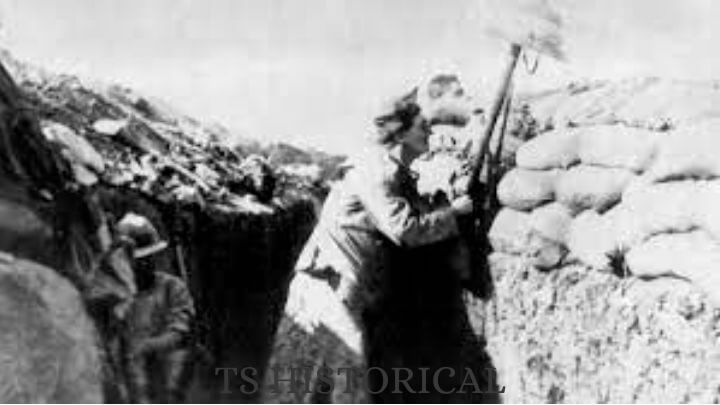
The Germans were astonished by their success. They had killed or captured so many Soviet troops that they were sure the Russians could not hold out. But as Fall approached, Soviet units kept arriving, and they were getting tougher. From late August to early September 1941, fighting continued near Kyiv.
The Red Army initially had around six hundred thousand troops in the area, and more arrived throughout September. The Germans started to lose their optimism, with many soldiers becoming sick of the endless Soviet plains. Their hopes for an early victory evaporated, with the Soviets continuing to meet them head-on and leading them deeper into the desolate landscape. As they advanced, the Nazis committed many atrocities, such as the murder of over thirty thousand Jewish people at Babi Yar. Since the end of World War 2, thousands of execution sites have been found all over Ukraine.
After the First Battle of Kyiv, Hitler moved the bulk of his forces north to Moscow, but by that time, winter had come. The siege lasted from October until January 1942, and the Germans would only get as far as seeing the spires of the Kremlin. Bolstered by the summer successes, they had pushed forward, but now the German soldiers found themselves in sub-zero temperatures without winter clothing. Supplies were running short, including gas. Machines and tanks had to be left running to prevent them from freezing–which did not help the situation. Frostbite incapacitated many German soldiers, sometimes resulting in their death.
On December 5th, with German morale low, Soviet forces attacked from the frozen mist. They had newly commissioned tanks that they had not even painted due to the hurried nature of their construction.
The Soviets managed to push back the Germans for hundreds of miles, and while the Germans did stabilize the front line, their hope of conquering Moscow were dead. Operation Barbarossa was a technical success, but even Hitler admitted that he had severely underestimated the Soviets. His early triumphs had reinforced his idea that he would easily defeat the Red Army, but while they were suffering losses, the Red Army was learning and refining their skills. They replaced their incompetent officers, and the newly appointed commanders gained more freedom to act. It was to be these same commanders that would lead the Red Army into Berlin in 1945.
The Soviets also successfully protected their industry, which had been another surprise for Hitler. Even in the face of such heavy losses, the courage and ferocity of the Red Army are undeniable.

Date: 22 June – 5 December 1941 (5 months, 1 week, and 6 days)
Location: Central Europe, (Northeast Europe), Eastern Europe
Context: World War II
Participants: Germany, Red Army, Soviet Union
Nazi Germany Invades Soviet Union
Nazi Germany launched Operation Barbarossa – the invasion of the Soviet Union – nearly two years after the start of World War II. It was one of the most sizable and deadliest conflicts of all time and one that the USSR would not recover from economically until the 1960s. The estimate is that over twenty million Russians lost their lives in this invasion. Overall, the Soviet Union suffered more losses than any other country involved in World War II.
Before war broke out, Josef Stalin, the communist leader of the Soviet Union, was working with the German military. World War I had ended less than amicably for the Germans, and many resented the outcome. Stalin allowed German armed forced to secretly train in the Soviet Union, as the Treaty of Versailles had placed limitations on Germany’s military.
In return, Germany supplied Stalin with machine parts and other goods. Despite being staunchly anti-communist, when Adolf Hitler assumed power, he continued taking advantage of this trade-off. Stalin knew that war with Germany was inevitable, as Hitler had asserted as much in his manifesto “Mein Kampf.” But he hoped to direct Germany’s attention to France and Britain, allowing him more time to strengthen his army.

In 1936, Adolf Hitler started to re-establish Germany’s power. He annexed Austria and took over Czechoslovakia, manipulating the French and British into standing down in the name of peace.
The Nazis then formed alliances with Hungary, Romania, Italy, and Japan. By the time Stalin realized what was happening, he found himself surrounded by German allies. With France and Britain unwilling to declare war, he had to negotiate with Hitler. Behind the announcement of trade agreements and a pledge not to go to war with each other, Hitler secretly agreed not to interfere if Stalin attacked Finland and also gave Stalin free reign to take over the Baltic States and parts of Romania.
They then divided Poland between them, which they felt was justified as Poland had been under Prussian and Soviet control before gaining its independence after World War I. While Stalin seemed to get the better end of this deal, what Hitler wanted was the assurance that the Soviets would allow Germany to wage war on France.
In September of 1939, Hitler and Stalin attacked Poland from opposite sides, their armies meeting on the agreed stopping lines to congratulate each other. World War II had begun. Shortly after this campaign, Stalin’s Red Army attacked Finland. Although Russia was victorious and the Finns had to cede parts of their territory, the Red Army did not perform well. The Finns outfought them, and it was only the Red Army’s weight in numbers that saved them from defeat. The reason behind the poor performance by the Red Army was Stalin’s paranoia.

In 1937, Mikhail Tukhachevsky – a popular Soviet military chief who wanted to modernize the military – was in charge of the Red Army. Some believe that Stalin saw Tukhachevsky as a rival, which caused him to purge the Red Army of anyone suspected of having anti-communist or anti-Stalin sentiment.
Thirty-seven thousand officers were either killed, sent to Siberian labor camps, or jailed. Marshals, generals, and admirals were all executed, along with roughly ninety percent of corps commanders and eighty-two percent of division generals. Along with these upper echelons, Stalin also removed some colonels, majors, and captains.
The communist thinking was that trained commanders weren’t necessary, as “revolutionary zeal” would be enough for them to prevail. By the time the Soviets went to war with Finland, most of the army’s officers were afraid of going against orders, so they dared not think for themselves. Revolutionary zeal meant the only strategy at their disposal was sending waves of men out to die.
Despite being outnumbered, the Finns held off the Soviets for two months. After heavy casualties, Stalin reorganized, adopting different tactics, renewed the offensive, and in February of 1940, the Finns negotiated the Moscow Peace Treaty.
The military incompetence displayed by the Soviets during the Winter War with Finland spurred Hitler to start Operation Barbarossa. He hoped for a quick victory to avoid the harsh Russian winter. However, he had greatly underestimated the industry and size of the Soviet Army.

The Germans amassed the largest invasion force in history (although the Soviets would beat this record in the coming years) supplemented by Finnish, Italian, Romanian, and Hungarian formations. Both sides had a vast array of weapons, including tanks and heavy artillery. Although the German tanks were inferior to many of the Allied tanks, the German’s training and tactics would gain them victories during the first two years of World War II.
The Germans overwhelmed their enemies by finding weak points, then send in tanks – supported by air attacks – through the enemy’s front line. These attackers continued to the rear, where they cut off supplies and communications. The German infantry would then follow and take out any enemy units still on the front line.
This style of operation was known as a blitzkrieg attack. Many people, including Winston Churchill, warned Stalin of Hitler’s intentions to invade, but he chose to ignore them. German reconnaissance planes were left unchallenged, with Stalin not wanting to provoke an incident unnecessarily.
He believed the Red Army was unprepared for conflict with Germany and wished to prevent it for as long as possible. Luckily for the Soviets, Stalin would listen to some intelligence from one of his agents in Tokyo later that year. The information was that Japan intended to go to war with the US rather than the USSR, which prompted Stalin to move vast numbers of militia from the east to Moscow. Shortly after 3 am on June 22, 1941, three million Germans and their allies stormed across the borders of Poland, the Baltic States, Ukraine, and Finland.
The Red army was entirely unprepared for this onslaught, and a large number of Soviet troops found themselves surrounded before they realized what was happening. During the first battle, nearly half a million Soviet soldiers lost their lives. Stalin was devastated. Ashamed that he had not believed Germany would attack, he didn’t speak publicly until over a week after the initial invasion. Stalin then abandoned his communist fervor, naming the defense effort the Great Patriotic War. He brought back forbidden symbols and old traditions to make the war more about national survival than communist ideals.
War of Annihilation

Hitler referred to this operation as a “war of annihilation.” He wanted to eliminate both the communist system – which promoted the unity of the working classes regardless of race – and the Soviet people themselves. There were about five million Jews in the Soviet Union, and along with the other Slavic populace, they were to be starved or worked to death by the Germans. As soon as the German army had penetrated the Soviet forces, the SS and other police units started rounding up anyone considered a danger to the Nazis.
The German troops pressed onward, pushing through weak points then meeting with other German forces to the rear of the Soviet units, cutting off sections of the Red Army from each other. With the purge of disobedient officers still fresh in their minds, the Red Army commanders were hesitant to act for themselves. As the Germans cut off communications, coordination was impossible. Within weeks the Germans had advanced hundreds of miles into the Soviet Union. Panic spread and civilians attempted to flee, but they found themselves surrounded and subject to bomb attacks from the Luftwaffe, the German Air Force. Surprisingly, people did not always view the Germans as an invading force.
In Ukraine, they were welcome as liberators from communist oppression, and despite many Ukrainians fighting against them, civilians often met German soldiers with traditional gifts andflower garlands. This reception, plus the success of the blitzkrieg, prompted the Nazis to believe victory was in their grasp. But the cold Russian winter was bearing down on them. Any friendliness shown to the Nazis upon their arrival soon disappeared when it became clear of their true genocidal intentions. Organized resistance began to grow and would continue to do so into the following year.
The Germans had not planned for a prolonged war, and deep into Soviet territory, their supplies began to run low. They had also sustained many casualties, and while the Soviets had a surplus of manpower, the Germans did not. As the weather got worse, the Red Army’s strengths began to show. Stalin had realized the negative effect of his management on the armed forces and gave more control to his generals. He allowed field commanders to decide how to organize their troops and when to attack or retreat.
In late November, military back-up from the east arrived, and the Red Army started modern training regimes. They became adept at the same tactics used against them by the Germans. Britain and the US, realizing the implications should Russia come under Nazi control, began sending large amounts of military aid, including arms, food, and factory parts.

Before the commencement of Operation Barbarossa, the Germans had to invade Grece due to Italy’s failed attack, which pushed the operation back by six weeks. Some argue that this six-week delay doomed them from the start, as it meant that the Germans did not reach Moscow until the beginning of winter 1941. Others maintain that had Hitler managed to take Moscow, it would not have affected the Soviets as they had already accomplished the extraordinary feat of moving most of their vital factories to the Ural Mountains, beyond the reach of the German bombers.
During the summer of 1941, millions of Soviet soldiers were taken as prisoners; some were imprisoned in unsanitary conditions and left to die of exposure, hunger, or disease. Hundreds of thousands were shot or sent to German-controlled countries to work in labor camps or die in concentration camps. Soviet prisoners of war were the first to be gassed at Auschwitz. Sadder still, those who survived the horrors of the war and made it back home were suspected of being spies or traitors by the communist government and sent to Soviet camps.

The Germans were astonished by their success. They had killed or captured so many Soviet troops that they were sure the Russians could not hold out. But as Fall approached, Soviet units kept arriving, and they were getting tougher. From late August to early September 1941, fighting continued near Kyiv.
The Red Army initially had around six hundred thousand troops in the area, and more arrived throughout September. The Germans started to lose their optimism, with many soldiers becoming sick of the endless Soviet plains. Their hopes for an early victory evaporated, with the Soviets continuing to meet them head-on and leading them deeper into the desolate landscape. As they advanced, the Nazis committed many atrocities, such as the murder of over thirty thousand Jewish people at Babi Yar. Since the end of World War 2, thousands of execution sites have been found all over Ukraine.
After the First Battle of Kyiv, Hitler moved the bulk of his forces north to Moscow, but by that time, winter had come. The siege lasted from October until January 1942, and the Germans would only get as far as seeing the spires of the Kremlin. Bolstered by the summer successes, they had pushed forward, but now the German soldiers found themselves in sub-zero temperatures without winter clothing. Supplies were running short, including gas. Machines and tanks had to be left running to prevent them from freezing–which did not help the situation. Frostbite incapacitated many German soldiers, sometimes resulting in their death.
On December 5th, with German morale low, Soviet forces attacked from the frozen mist. They had newly commissioned tanks that they had not even painted due to the hurried nature of their construction.
The Soviets managed to push back the Germans for hundreds of miles, and while the Germans did stabilize the front line, their hope of conquering Moscow were dead. Operation Barbarossa was a technical success, but even Hitler admitted that he had severely underestimated the Soviets. His early triumphs had reinforced his idea that he would easily defeat the Red Army, but while they were suffering losses, the Red Army was learning and refining their skills. They replaced their incompetent officers, and the newly appointed commanders gained more freedom to act. It was to be these same commanders that would lead the Red Army into Berlin in 1945.
The Soviets also successfully protected their industry, which had been another surprise for Hitler. Even in the face of such heavy losses, the courage and ferocity of the Red Army are undeniable.
Discover more from TS HISTORICAL
Subscribe to get the latest posts sent to your email.

